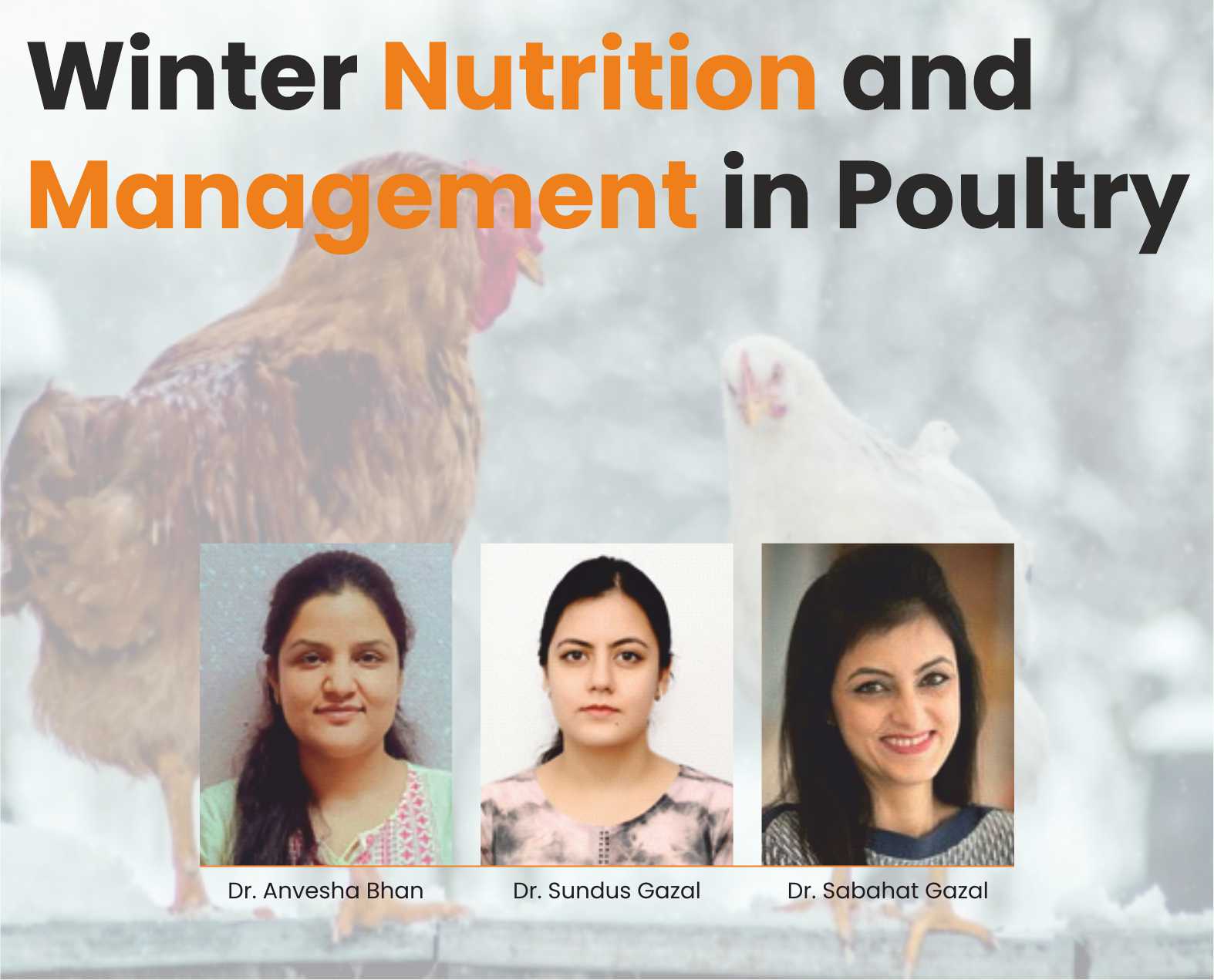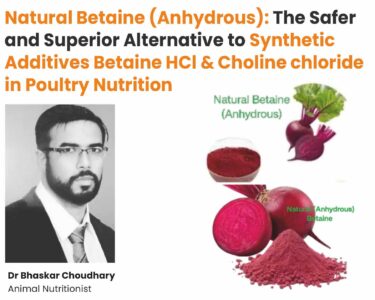Winter Nutrition and Management in Poultry

Dr. Anvesha Bhan1, Dr. Sundus Gazal2 and Dr. Sabahat Gazal3
Division of Veterinary Microbiology and Immunology, Sher-e-Kashmir University of
Agricultural Sciences and Technology of Jammu
Introduction
India has a remarkable diversity of climate zones, from tropical in the south to alpine and moderate in the Himalayan north, where highlands see heavy snowfall in the winter. Such diverse climatic challenges and extremes lead to variations in managemental practices across different parts of the country. Winter poses formidable temperature challenges, making it challenging to sustain both livability and production without additional measures. Managing winter conditions is often said to be like a double-edged sword, requiring a delicate balance between climate and ventilation management. Strategic decision-making is essential to minimize production costs while ensuring a healthy environment. Experience is crucial in gauging the economic feasibility of cost-intensive management practices. The art and science of poultry rearing hinge significantly on effective management, playing a pivotal role in determining the profitability of the business. Over the past several years, it has been noted that peak market rates for broiler meat and eggs occur during difficult winter rearing conditions when demand surpasses supply. Hence, a comprehensive understanding and implementation of optimal management practices are imperative during the winter season.
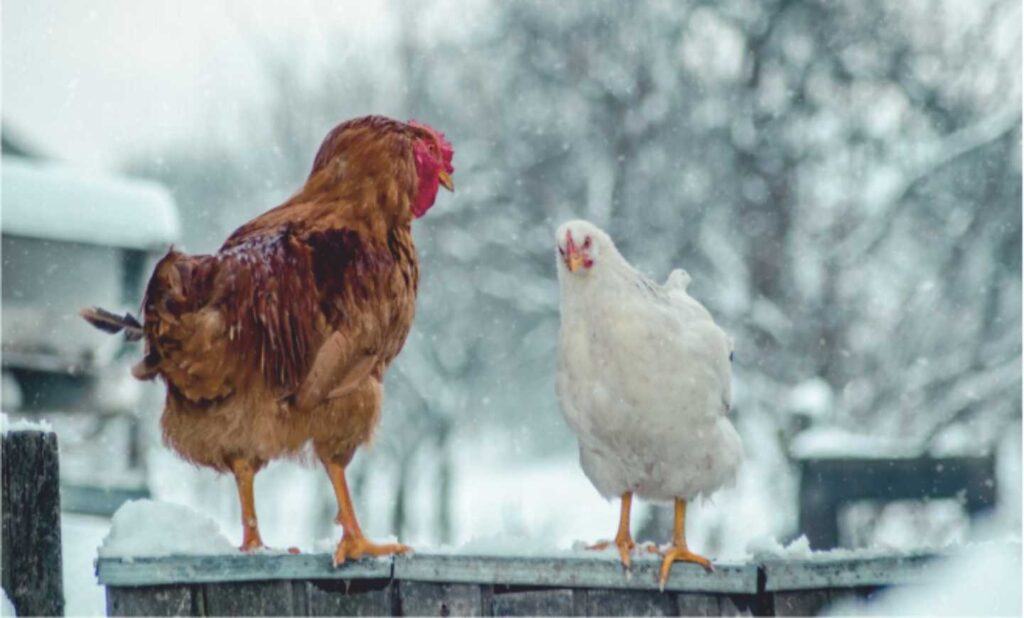
During the winter season, when temperatures fall below 55°F, poultry faces various challenges such as a decline in egg production, reduced water consumption, lower fertility and hatchability rates, inefficient feed conversion in broilers, diminished weight gain, lower fertility, increased bird mortality, and more. These climate-related changes can have direct or indirect impacts on both egg and meat production. Consequently, poultry farmers need to be prepared to address these challenges by implementing cold stress-relieving measures to mitigate potential economic losses. Thus, poultry farmers need to implement various measures to enhance poultry production during the winter season.
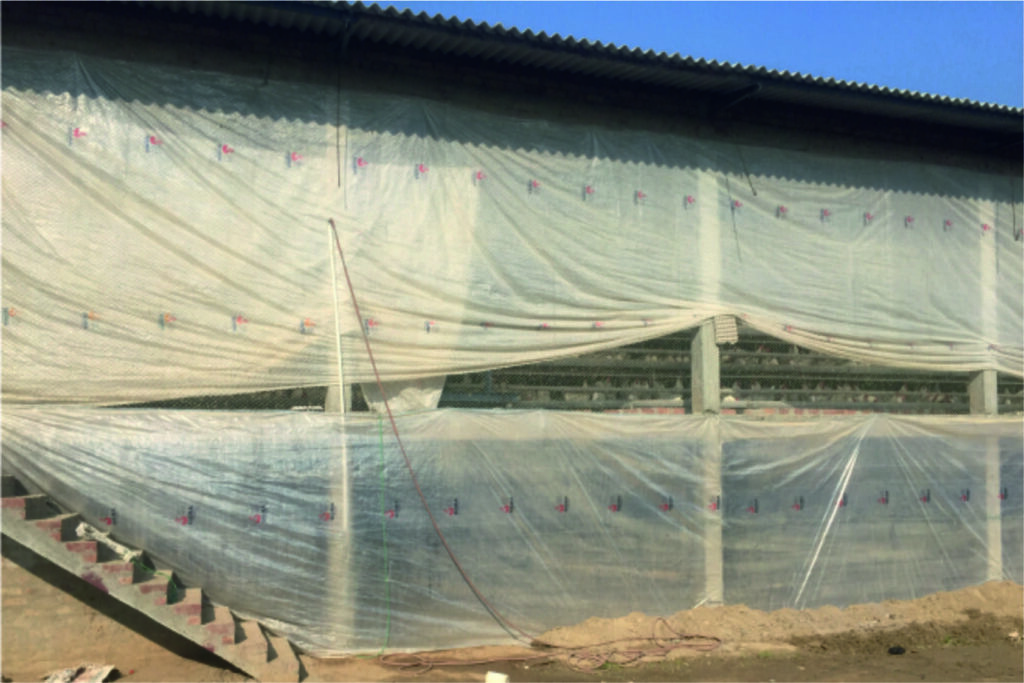
Proper orientation of the poultry house
The poultry house should be meticulously designed to ensure optimal comfort for the birds during the winter season. The orientation of the building in relation to wind and sunlight significantly impacts the temperature and light exposure on various external surfaces. In winter, when the sun’s visible path is shortened, aligning a rectangular house in the east-west orientation maximizes solar energy absorption. The design should prioritize the allowance of maximum sunlight into the shed during the daytime. To shield the birds from chilling winds, precautionary measures can be taken by hanging gunny bags at points where cold air enters. These bags should be lowered in the evening after sunlight diminishes and raised again in the morning before the sunlight reappears, creating a barrier against cold drafts.
Effective management of ventilation
Birds naturally release a significant amount of moisture through their breath and droppings, which can have adverse effects on their health. Inadequate ventilation contributes to the accumulation of ammonia in the air, posing respiratory threats. Therefore, it is crucial to ensure sufficient fresh air circulation within the poultry shed. Sliding the windows open during the day serve this purpose by allowing ventilation and the windows should be closed at night. Installing exhaust fans in poultry sheds is another effective measure to expel impure air. To maintain warmth in the poultry shed, traditional BUKHARIS or heaters can be installed. In smaller-scale poultry farming, the use of multiple 200W bulbs can also generate heat and contribute to maintaining a comfortable temperature for the birds.
Adequate poultry litter management
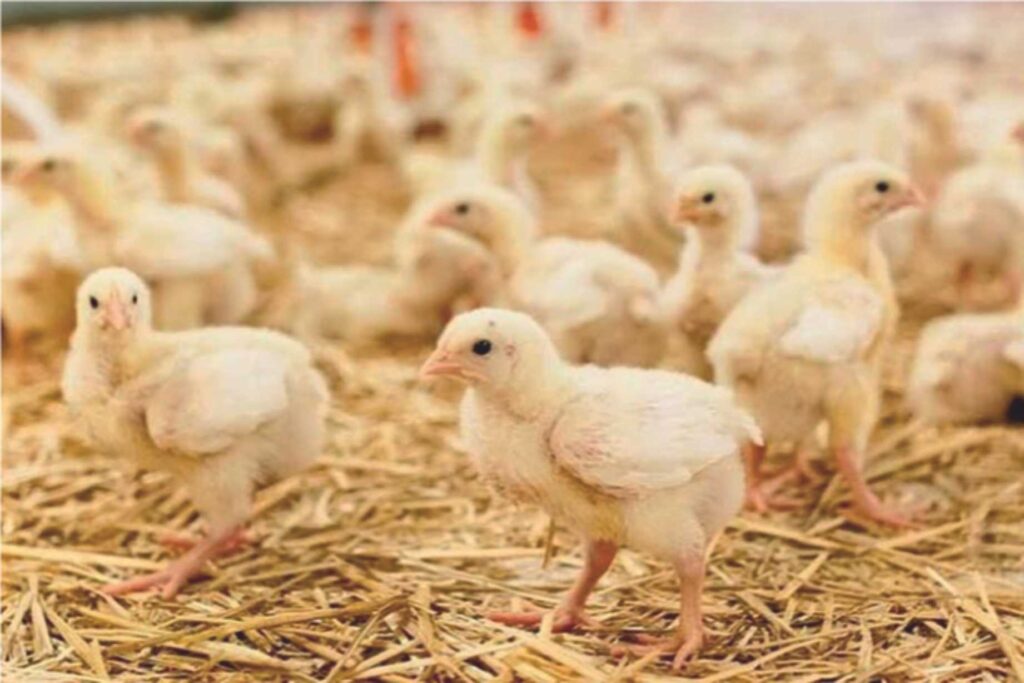
Before introducing chicks to the shed, it is essential to establish a stable floor surface by using a bedding material known as litter. This not only provides comfort to the birds but also serves various important functions. A sufficient quantity of high-quality bedding material contributes to insulation by maintaining a consistent temperature. Additionally, it absorbs excess moisture, preventing dampness, and promotes drying. The litter helps in breakdown of fecal matter, thus reducing the likelihood of contact between the birds and their waste. Furthermore, it acts as a barrier between the birds and the cold ground, serving as a cushion. An optimal depth of around 6 inches of bedding material or litter is recommended during the winter season, as it provides ample warmth to the birds. The moisture content in the litter should ideally be maintained within the range of 25-35%. However, proper management is crucial to prevent the litter from becoming excessively wet due to water from various sources. Wet litter can lead to the formation of cakes, providing an ideal environment for bacterial growth and ammonia production. If the litter becomes excessively wet and cakes are formed, it is advisable to replace it. During the winter season, it is generally not recommended to completely empty the shed, as the built-up litter helps retain heat. If litter removal is necessary, only a portion should be removed to maintain a suitable environment for the birds.
Strategic poultry feeding management
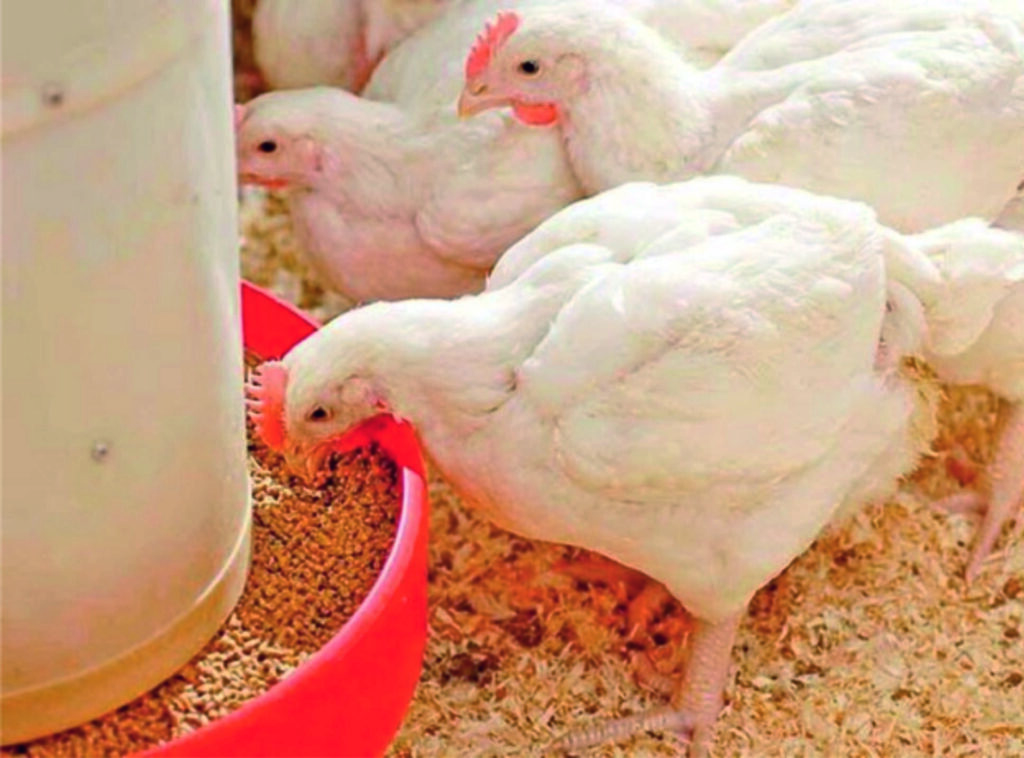
Poultry utilizes nutrients from food for two primary purposes: as an energy source to maintain normal body temperature and support physiological functions, and as building materials for the development of bones, feathers, flesh, eggs, etc. Therefore, it is essential to provide poultry with an adequate, well-balanced, and nutritious diet to meet these needs. In colder temperatures, there is an increased demand for feed consumption and oxygen. Hence, it is necessary to supply birds with an ample amount of food, as they require extra energy to maintain their body temperature during the winter season. Caloric intake per bird per day fluctuates with variations in environmental temperature. When poultry consumes more feed for energy, it also ingests excess nutrients that become wasteful.
To prevent such wastage during winter, it is advisable to include energy-rich feed sources like oil or fat in the diet. Increasing the number of feeders in winter compared to summer is recommended, and feed should be made available to the birds throughout the day. In terms of nutritional content, a winter diet should consist of 3400 kcal/kg ME and 23% protein, as compared to a summer diet requiring 3100 kcal/kg ME and 23% protein. Providing poultry with high-calorie feed in the winter helps keep them warm. It is crucial to store the feed in dry places to prevent moisture contact and maintain its quality.
Efficient poultry water management
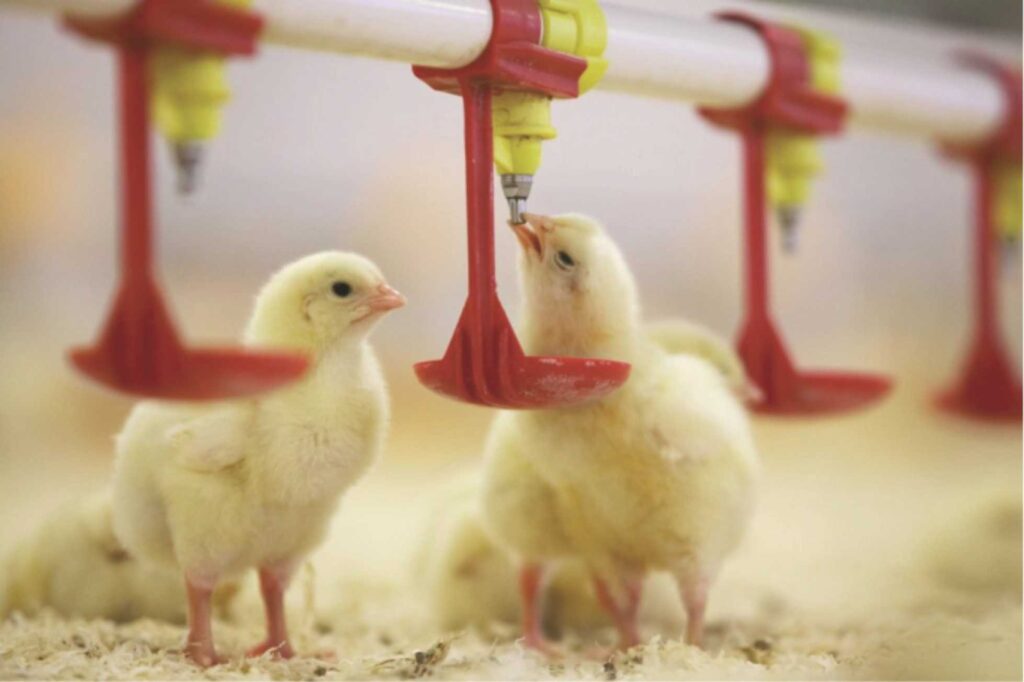
During the winter season, poultry may require less water, but it is crucial to ensure a continuous supply of fresh and clean water for proper hydration. If the water is very cold, it should be provided to the birds after adding hot water to bring it to a normal temperature. Regions experiencing snowfall often encounter issues with pipe blockages due to water freezing in the winter when temperatures drop below 0°C. To prevent such problems, regular inspections of pipelines should be conducted to avoid water blockages. Water serves as a carrier for various vaccines, medicines, and anti-stress vitamins for poultry. Since water intake decreases during the winter season, it is important to remove waterers a few hours before water medication. Medicines or vaccines should be administered in a smaller amount of water, ensuring that each bird consumes the total water and receives the full benefits of the medication, vaccine, or other supplements. Careful attention to water management is essential to maintain the health and well-being of poultry during winter.
Implementation of supplementary management
The poultry environment is conducive to pests and rodents that are also seeking warmer places for habitation, thus making their control extremely crucial. Poultry farmers must be vigilant about winter illnesses, as neglecting them can pose a serious threat to the flock. Maintaining gut health is essential for optimal performance and preventing business losses. Various feed additives play a critical role in supporting and enhancing gut health, including Protease, NSPase Enzyme, Probiotics, Essential Oils, Organic Acids, etc. Organic Acids like coated benzoic acids not only reduce pathogenic bacteria such as Clostridium and Salmonella but also enhance the inhabitation of Lactobacillus in the gut.
Essential oils primarily function as digestive enhancers and also have immune-boosting properties. They aid in the effective digestion of nutrients in the early stages where endogenous enzymes may not be fully active. Additionally, essential oils impede quorum sensing, acting as natural antibacterials. In case of illness, following the standard protocols is crucial. This includes isolating sick birds through quarantine, administering various broad-spectrum antibiotics via feed or water (depending on availability), and ensuring proper vaccination. Poultry farmers should regularly check the vaccination status and promptly consult a local veterinarian when birds are found to be unwell. This proactive approach is vital for maintaining the health and well-being of the poultry flock.


